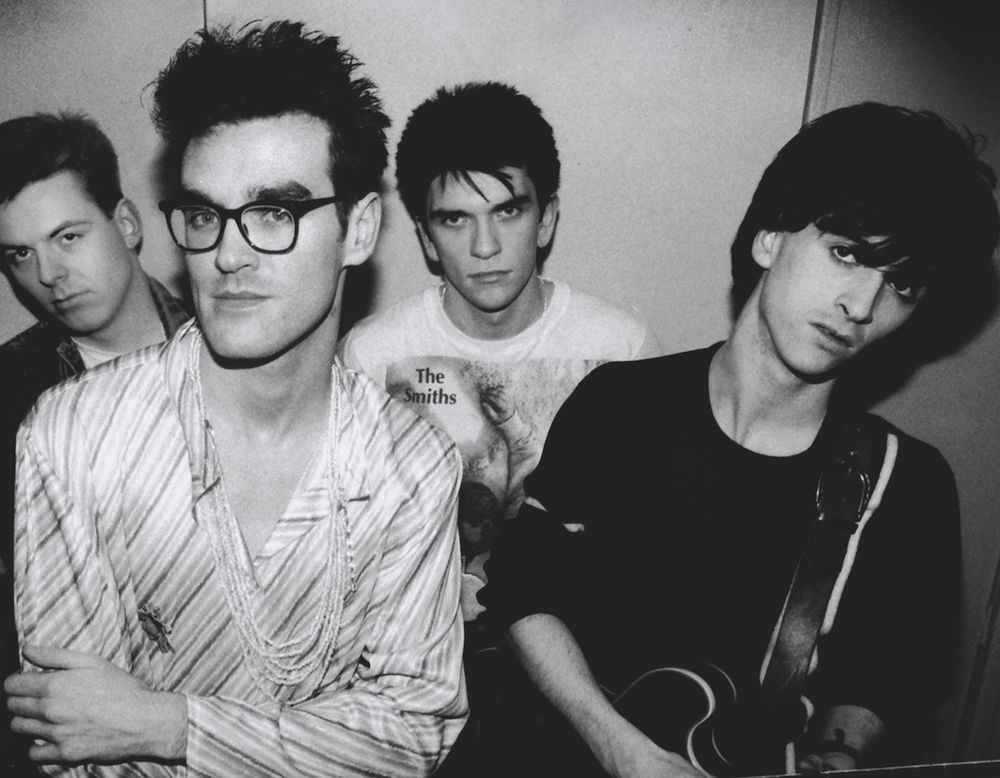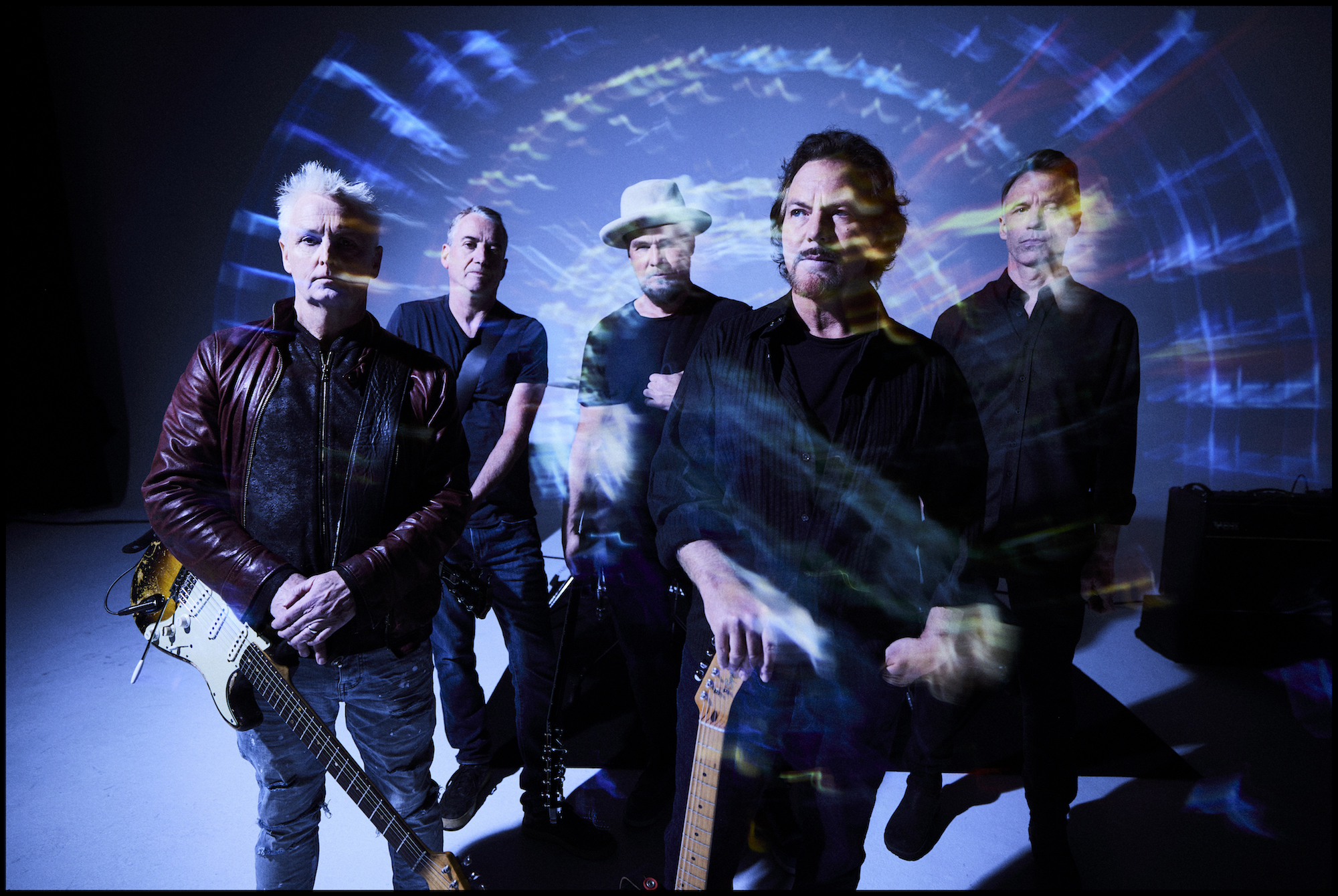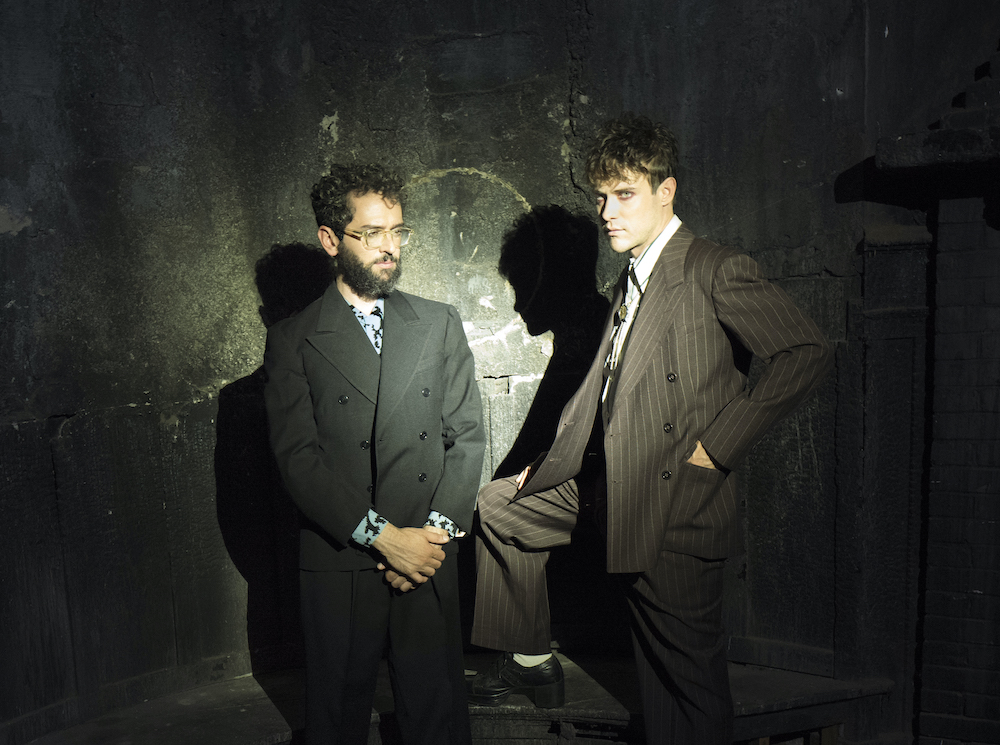Looking back it's almost hard to believe.
Three members of the quintessential post-punk band choose to carry on after the suicide of their lead singer and bandleader only to become dancefloor innovators, stumbling into exponentially greater fame and success, finding their way to arenas, FIFA theme songs, and everywhere in between.
To many, Joy Division was Ian Curtis. Upon his death in 1980, it made a certain kind of sense to lay Joy Division to rest as well, despite the fact the band was ending as their (hugely influential, impossibly important) second album was set for release, literally on the eve of their first American tour. Clearly there was unfinished business. Only two months later, surviving bandmates Bernard Sumner (guitar), Peter Hook (bass), and Stephen Morris (drums) reconvened on stage at Manchester's Beach Club. The unnamed trio would become New Order.
The choice of name is telling. Despite an obvious surface similarity in sound, New Order were quick to step away from Joy Division's abrasive minimalism. Incorporating new sounds and new ideas, New Order embraced the technology of the times -- drum machines, samplers, sequencers, synths, and arpeggiators -- and took cues from the burgeoning world of electronic dance before gradually learning to write pop songs. Post-punk, synth-pop, and dance music were nothing new at the time: New Order broke the mold by combining all three, striking a balance between sequenced compositions and those of an actual band playing actual instruments. Even at their most electronic, the songs feel organic.
Where Joy Division records were occasionally sloppy and frequently noisy, New Order presented a polished package every time. Bernard Sumner's laconic guitar playing became even sparser than before, often conceding the melodic role to Peter Hook's bass, operating as more of a rhythm instrument. And Peter Hook's bass playing is something all its own. For a band that openly embraced ambiguity and seemed to take pride in depersonalization (they rarely did interviews in the '80s, and their Peter Saville-designed album artwork was often unlabelled), Hook's bass provided the single loudest "voice" in the band: driving and immediately recognizable, consistently moody but expressive.
It's easy to look at New Order as a singles band -- the singles are massive, domineering things (I'm sitting here at my desk trying NOT to chair-dance to "State Of The Nation" as I type this) -- but ignoring the twists and turns of the often-brilliant studio albums would paint an incomplete picture. Listening to the early classic, Power, Corruption & Lies, straight through shows an entirely different band than you see on the original singles comp, Substance 1987. And that's half the fun with New Order -- they're nothing if not adaptable to your needs. With a new album out just this week -- their first in eight years, a continuation of Waiting for the Sirens' Call titled Lost Sirens -- now's as good a time as any to revisit the best songs of their career.
10. "Crystal" (from Get Ready, 2001)
New Order's comeback single off their (much-needed) comeback album had no business being this good. Coming eight years after their last studio album (1993's Republic), Get Ready recast the band as something they'd never been: a rock band. Big beat, guitar-driven Britpop from a band known for post-punk and dance tracks? It didn't feel in line with the times, and it didn't feel much like the New Order we knew; rather, it was an album-length expansion of their last big hit, "Regret." But they rose to the occasion, pairing confidence of execution with head-on hooks, and it was good. The strongest song from a collection of strong songs, "Crystal" is all thrust and propulsion; the kind of song meant for a late-night autobahn run as much a late-night roll in the hay. I like to think they got the idea for sexy-lady vocals from the likeminded late-career reinvention of "Come Undone," but that might be a stretch.
9. "Dreams Never End" (from Movement, 1981)
It's a little spooky when the vocals kick in on this one: that's Peter Hook taking a rare vocal turn, doing an uncanny impersonation of his old Joy Division bandleader. New Order frequently deride their first album as undeveloped, but several songs are straight-up classics -- this one in particular. Where the earliest singles sounded almost exactly like Joy Division with nondescript vocals (see: "Ceremony"; it's still great), here the band took the first steps toward finding its voice. When the song finally kicks in around the minute-mark, we realize this is something new: there's a spring in their step; the guitars chime and bloom in a way Joy Division simply refused to. The vocals might sound gloomy on first blush, but the song is about life rather than death -- it's a sendoff to the old and a declaration of intent for the new. The title is self-referential: In the old Joy Division track "Insight," Ian sang, "Guess your dreams always end." Not so for New Order.
8. "Elegia" (fromLow-Life, 1985)
Smack-dab in the middle of New Order's best album, they went and threw us a knuckleball: "Elegia" is the only dirge they'd ever write. It's also fully instrumental. The version appearing on Low-Life is just a five-minute snippet of a much longer work -- the full version clocks in at an eye-watering 17 and a half minutes -- meant to be the definitive tribute to the gone-but-strangely-present Ian Curtis. Like an instrumental "Shine On You Crazy Diamond" played in a rainy cemetery. The massive 17-minute version builds to a guitar freakout noisier than anything they would ever do before or since, a rare cathartic release for a band built on dance beats and simple emotions: It's a glorious thing to behold.
7. "Regret" (from Republic, 1993)
New Order have a habit of putting their best foot forward -- the strongest song (and in many cases the biggest single) tends to be the first song on a given album. "Dreams Never End" on Movement; "Age of Consent" on Power, Corruption & Lies; "Fine Time" on Technique; even "Crystal" on Get Ready. Republic follows suit, slotting "Regret" in pole position; the track easily mops the floor with everything that would follow, which mostly felt like lazy club jams you'd hear in the bathroom of a nightclub in Ibiza (was it any surprise Peter Hook named his side project Monaco?). But a closer look reveals an interesting shift in band dynamics as it unfolds: The meticulous rhythm arrangements of days past are efficiently swapped for stripped-down stock beats, which forces the guitar and vocal to the forefront. Suddenly it's the Bernard Sumner show, even as Peter Hook's bass lead proves a perfectly subtle counterpoint to one of Sumner's strongest choruses. Change was afoot in the New Order camp, as we'd see on Get Ready and later releases.
6. "Temptation" (single, 1982)
And this is where it all started, where the New Order we know and love found its voice and broke out in song (and, for the first time, dance). Movement and the earlier singles were pretty gloomy, carrying the pallor of later Joy Division into the newer project, even as a glimmer light began to creep in around the edges. "Temptation" drew back the curtain and let that light flood in: Suddenly this was dance music, this was uptempo, and check out that chorus! Who knew Bernard Sumner could step it up and bust out a doe-eyed romantic gem of this caliber? "Oh, you've got green eyes. Oh, you've got blue eyes. Oh, you've grey eyes. And I've never seen anyone quite like you before." Simple and naïve but breathless in its excitement, it's the perfect makeout soundtrack for the awkward kids of any age, in any era.
5. "Blue Monday" (single, 1983)
Backwards, forwards, inside out: You'd recognize this song in your sleep, it's so overplayed. It's a shame in a way: I bet most folks assume this is the New Order sound. The most stereotypical "'80s" sounding thing they ever did, the vocals come off uncharacteristically cold, at least compared to the other hits. It's in keeping with the darker tone of the earliest stuff, it just happens to be catchy -- the bass and rhythm programming could easily pass as something from one of their synthier contemporaries (Human League, OMD, whoever). Yet it's a bona fide hit: Supposedly "Blue Monday" is the top-selling 12" single of all time -- meaning disc jockeys ate this up, with good reason. "How does it feel?" Those four words cut the air like a frozen knife. Listening to the entire song -- all seven and a half robotic minutes -- the genius of the arrangement shines through: The synthetic bass line almost imperceptibly pushes and pulls against the beat, making a mostly static rhythm feel propulsive, and the drum fill is more memorable than any single melody -- no small feat. Hell, even Orgy couldn't ruin it.
4. "True Faith" (single, 1987)
For a band so reliant on imaginative rhythm programming and complex variations of simple bits and pieces, it's funny to see one of their most accomplished tracks laid out so simplistically. The drums do one thing: stomp. The synth bass rolls right along, locked in the same bouncing-ball pattern forever. There's hardly any flash on display: everything in service to everything else, all bowing to the simplicity of the song itself. Even Peter Hook, who shows up for his usual lead-bass acrobatics, is relatively restrained, in part due to the density of the mix. So it falls to the vocal to keep our attention -- what we get is Bernard Sumner singing simply, plainly, effortlessly, somehow delivering some of the strongest lyrics of his career inside one of the band's very best songs. Verses and pre-choruses bleed together -- even the chorus hits before we realize it -- but it's fucking perfect, so who cares? We bounce to the beat, the melody leads the way, we all win. Don't be misled by the title; this is a drug song if ever there was one.
3. "Age Of Consent" (from Power, Corruption, & Lies, 1983)
When you write a bass line this good you better believe it's gonna get played through the whole goddamn song. Sure, Peter Hook mixes it up (a hair) once the vocals kick in, but "Age Of Consent" is essentially one perfect bass part played for five minutes. Again, proving the "best track first" rule on Power, Corruption, & Lies, "Age of Consent" presents a perfect opportunity for the rest of the band to vamp while Hook and drummer Stephen Morris hold it all down. Bernard Sumner cuts loose with gentle, meandering solos offset by jagged rhythm guitars, all while relating a plaintive tale of a relationship gone south. Keyboardist Gillian Gilbert occasionally pulls up a synth patch that feels strangely like the synth from "Love Will Tear Us Apart", lending "Age Of Consent" the weight and consequence to stand tall in the shadow of its untouchable forebear. It's wistful, it's playful, and it's just this side of perfect.
2. "Bizarre Love Triangle" (from Brotherhood, 1986)
Where "Blue Monday" tidily steals the crown of best known and most recognizable New Order song, it’s "Bizarre Love Triangle" that really ought to reign supreme. You get everything you want and nothing you don’t: Peter Hook’s sinuous bass paired with Bernard Sumner’s sharpest lyric, and vibrant synths set against a perfect dance backdrop. If someone asked you what New Order sounds like, you couldn’t choose a more definitive track than this, really. Funny thing: Just like "Blue Monday", it’s a safe bet an entire generation (those of us weaned on Alternative Nation) learned this song by way of the coffee-shop murmurings of Frente! (the exclamation point and associated enthusiasm is theirs). Frente!'s rendition stripped "BLT" to its core lyric and replaced everything good about the arrangement with a nose ring and an acoustic guitar -- that it doesn’t really suck is a testament to the unshakeable strength of the song itself.
1. "The Perfect Kiss" (from Low-Life, 1985)
For years I had no idea where the title came from, or what it meant. Ambiguous titles are a New Order staple; this one felt especially strange in light of the actual lyrics. Come to find out the version I knew (from the Low-Life album) had been cut practically in half. At a tidy 4:51, the album version excises several minutes of dance-floor aerobics as well as an entire verse's worth of lyrics from the original 12" cut*. The title actually appears in those chopped lyrics, changing the meaning of the song altogether: "My friend he took his final breath. Now I know the perfect kiss is the kiss of death." Another song about Ian Curtis? Probably. Somehow it's in this unsuspecting single that you find every facet of New Order rolled into a sprawling mini-suite that doubles as one of the best dance tracks of all time: what starts out like a lighthearted love song (the chorus goes: "I know, you know, we believe in a land of love") turns into a brooding meditation on death. Each band member's presence is felt intimately: Gillian's keys dominate the majority of the tune; Bernard plinks along on his guitar, providing the funk you'd usually associate with a bass; speaking of bass, Peter Hook leads the melody the whole way through, and his explosive finale riff ranks as the best thing he'd ever play. Drummer Stephen Morris brings the humor that underlies so much of New Order's catalog (see "Every Little Counts" with his addition of "synth frogs" over the bridge. It's a long song, one that travels and takes you with it; in turns playful and dramatic, danceable and exhausting, it's everything all at once, a perfect kiss and a little taste of death.
* "The Perfect Kiss" appeared in numerous versions over the years: the full 12" vinyl version is 8:51 long, while the mislabeled version [accidentally omitting the word "The"] on Substance 1987 is edited to 8:02. The Jonathan Demme-directed music video features an entirely new recording of an alternate in-studio performance that lasts over 9 minutes, full of unglamorous close-ups that showcase the quiet concentration of each band member and a charmingly loose vocal from Bernard. As counterintuitive as it sounds, watching the band dispassionately tear through a song this massive while barely moving is both hilarious and surprisingly effective.
//
Stream this countdown as a Spotify playlist here.






